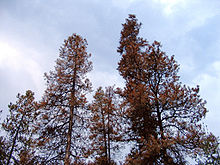- Bark beetle
-
- The unrelated sawyer beetles (Monochamus) and some other wood-boring beetle taxa (especially Cucujoidea) are sometimes called "bark beetles" too.
Bark beetles 
Mountain pine beetle,
Dendroctonus ponderosaeScientific classification Kingdom: Animalia Phylum: Arthropoda Class: Insecta Order: Coleoptera Family: Curculionidae Subfamily: Scolytinae
Latreille, 1807Tribes Cortylini
Cryphalini
Crypturgini
Dryocoetini
Hylastini
Hylesinini
Hypoborini
Ipini
Phloeosinini
Phloeotribini
Polygraphini
Scolytini
Scolytoplatypodini
Taphrorychini
Thamnurgini
Tomicini
Xyleborini
XyloteriniA bark beetle is one of approximately 220 genera with 6,000 species of beetles in the subfamily Scolytinae. Traditionally, this was considered a distinct family Scolytidae, but now it is understood that bark beetles are in fact very specialized members of the "true weevil" family (Curculionidae). Well-known species are members of the type genus Scolytus - namely the European elm bark beetle S. multistriatus and the large elm bark beetle S. scolytus, which like the American elm bark beetle Hylurgopinus rufipes, transmit Dutch elm disease fungi (Ophiostoma). The mountain pine beetle Dendroctonus ponderosae, southern pine beetle Dendroctonus frontalis and their near relatives are major pests of conifer forests in North America. A similarly aggressive species in Europe is the spruce Ips Ips typographus. A tiny bark beetle—the coffee berry borer, Hypothenemus hampei is a major pest of coffee around the world.
Contents
Ecology
Bark beetles are so-named because the best known species reproduce in the inner bark (living and dead phloem tissues) of trees. Some species, such as the mountain pine beetle (Dendroctonus ponderosae), attack and kill live trees. Most, however, live in dead, weakened, or dying hosts. Bark beetles are ecologically and economically significant.[1] Outbreak species help to renew the forest by killing older trees. Other species aid in the decomposition of dead wood. However, several outbreak-prone species are known as notorious pests.
Bark beetles often attack trees that are already weakened by disease, drought, smog, conspecific beetles or physical damage. Healthy trees may put up defenses by producing resin or latex, which may contain a number of insecticidal and fungicidal compounds that can kill or injure attacking insects, or simply immobilize and suffocate them with the sticky fluid. Under outbreak conditions, the sheer number of beetles can, however, overwhelm the tree's defenses, and the results can be disastrous for the lumber industry.
In some places, such as the Šumava National Park in the Czech Republic's Bohemian forest, problems with bark beetles have become a heated issue with a political dimension. On one side, some experts (usually with a background in environmental sciences) demanded that nature be left alone and that natural processes be allowed to take their course, even if it meant the bark beetle would destroy most of the forest. On the other side, other experts (usually with a background in forest management[citation needed]) demanded intervention. During the 1980s and 1990s, the Šumava park management mostly favored intervention. Many outside groups became involved in the dispute, such as the lumber industry (which supported intervention because of possible profit to be made), or some local politicians, afraid that tourists would turn back from a forest decayed after a beetle invasion. The anti-intervention side got support from entomologists from the Czech Academy of Sciences and from several environmental organizations, such as Friends of the Earth. At the height of the dispute, there were cases where activists literally defended the trees with their bodies, tying themselves to the trunks, and the dispute was widely covered in the main Czech daily newspapers and on TV news.[2]
Some bark beetles form a symbiotic relationship with certain Ophiostomatales fungi, and are named "ambrosia beetles" after these "ambrosia fungi". The ambrosia beetles (such as Xyleborus) feed on fungal "gardens" and are one of only three insect groups known to farm fungi. The other two groups are ants and termites, neither of which is particularly closely related to beetles. Courtesy of the fungus, ambrosia bark beetles are able to indirectly feed from many more species of trees than their evolutionary relatives that do not feed on fungi, by having the fungi do the work of overcoming the plants' chemical defenses. The beetles carry the fungal spores in special structures, called mycangia, and inoculate the trees as they attack them.
Like many other insects, Scolytinae will emit pheromones to attract conspecifics which are thus drawn to trees already colonized by bark beetles. This can result in heavy infestations and eventually death of the tree. Many are also attracted to ethanol, one of the byproducts of microbial growth in dead woody tissues.
Gallery
References
- ^ http://www.usu.edu/beetle/
- ^ Daniela Lazarová (2003-08-21). "Czech National Park infested with bark beetle". Radio Praha. http://www.radio.cz/en/article/44362. Retrieved 2008-07-08.
External links and further reading
- American and Mexican Bark and Ambrosia beetles
- Southern Pine Beetle on the Forest Encyclopedia Network
- PaDIL Sheet on Scolytus scolytus
- Don't Move Firewood - Forest pests that are destroying our trees and forests
- Dendroctonus frontalis, southern pine beetle
- Dendroctonus terebrans, black turpentine beetle
- Ips, engraver beetles
- Species Profile- European Spruce Bark Beetle (Ips typographus), National Invasive Species Information Center, United States National Agricultural Library. Lists general information and resources for European Spruce Bark Beetle.
- Nordhaus, Hannah. Bark Beetle Outbreaks in Western North America: Causes and Consequences. University of Utah Press: Salt Lake City, 2009. ISBN 978-0-87480-965-7
Categories:- Curculionidae
- Woodboring beetles
- Insect pests of temperate forests
Wikimedia Foundation. 2010.







